University Report: Risk Assessment of the New NSW Trains Project
VerifiedAdded on 2023/01/20
|16
|3302
|55
Report
AI Summary
This report provides a comprehensive risk assessment of the new NSW trains project, focusing on the modernization of the regional rail fleet. It identifies five key risk categories: site risks, material risks, design risks, WHS risks, and environmental risks. For each risk, the report offers a detailed description, potential impacts, and proposed mitigation strategies. The assessment emphasizes the importance of a structured risk management plan, including employee training, adherence to safety standards, and compliance with environmental regulations. The report highlights the significance of considering passenger and worker safety, along with the economic and environmental impacts of the project. The recommendations include forming a detailed risk management plan, ensuring employee training, and the application of ISO standards for materials and processes. The report emphasizes the importance of proactive risk management to ensure the successful and safe execution of the project.
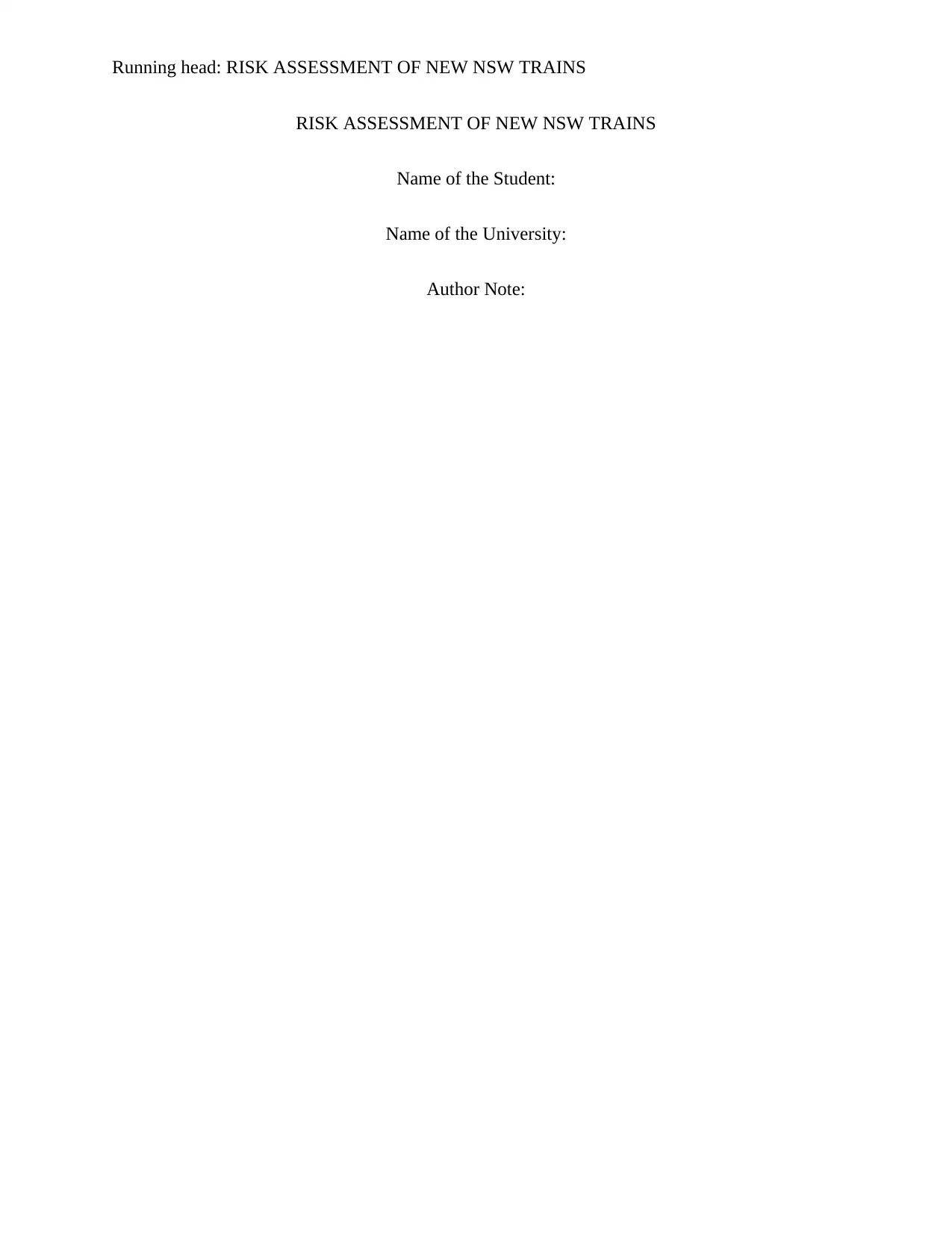
Running head: RISK ASSESSMENT OF NEW NSW TRAINS
RISK ASSESSMENT OF NEW NSW TRAINS
Name of the Student:
Name of the University:
Author Note:
RISK ASSESSMENT OF NEW NSW TRAINS
Name of the Student:
Name of the University:
Author Note:
Paraphrase This Document
Need a fresh take? Get an instant paraphrase of this document with our AI Paraphraser
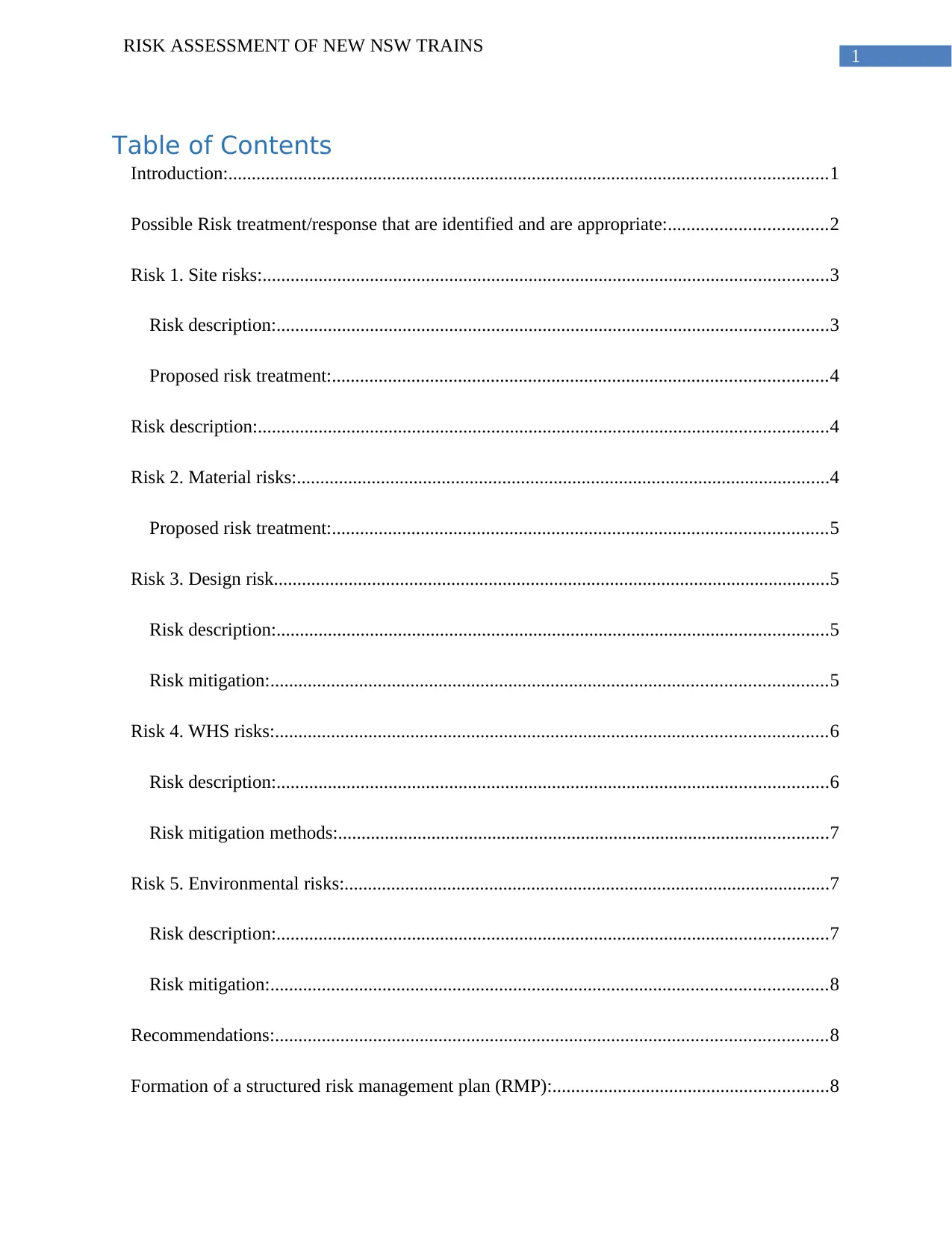
1
RISK ASSESSMENT OF NEW NSW TRAINS
Table of Contents
Introduction:................................................................................................................................1
Possible Risk treatment/response that are identified and are appropriate:..................................2
Risk 1. Site risks:.........................................................................................................................3
Risk description:......................................................................................................................3
Proposed risk treatment:..........................................................................................................4
Risk description:..........................................................................................................................4
Risk 2. Material risks:..................................................................................................................4
Proposed risk treatment:..........................................................................................................5
Risk 3. Design risk.......................................................................................................................5
Risk description:......................................................................................................................5
Risk mitigation:.......................................................................................................................5
Risk 4. WHS risks:......................................................................................................................6
Risk description:......................................................................................................................6
Risk mitigation methods:.........................................................................................................7
Risk 5. Environmental risks:........................................................................................................7
Risk description:......................................................................................................................7
Risk mitigation:.......................................................................................................................8
Recommendations:......................................................................................................................8
Formation of a structured risk management plan (RMP):...........................................................8
RISK ASSESSMENT OF NEW NSW TRAINS
Table of Contents
Introduction:................................................................................................................................1
Possible Risk treatment/response that are identified and are appropriate:..................................2
Risk 1. Site risks:.........................................................................................................................3
Risk description:......................................................................................................................3
Proposed risk treatment:..........................................................................................................4
Risk description:..........................................................................................................................4
Risk 2. Material risks:..................................................................................................................4
Proposed risk treatment:..........................................................................................................5
Risk 3. Design risk.......................................................................................................................5
Risk description:......................................................................................................................5
Risk mitigation:.......................................................................................................................5
Risk 4. WHS risks:......................................................................................................................6
Risk description:......................................................................................................................6
Risk mitigation methods:.........................................................................................................7
Risk 5. Environmental risks:........................................................................................................7
Risk description:......................................................................................................................7
Risk mitigation:.......................................................................................................................8
Recommendations:......................................................................................................................8
Formation of a structured risk management plan (RMP):...........................................................8
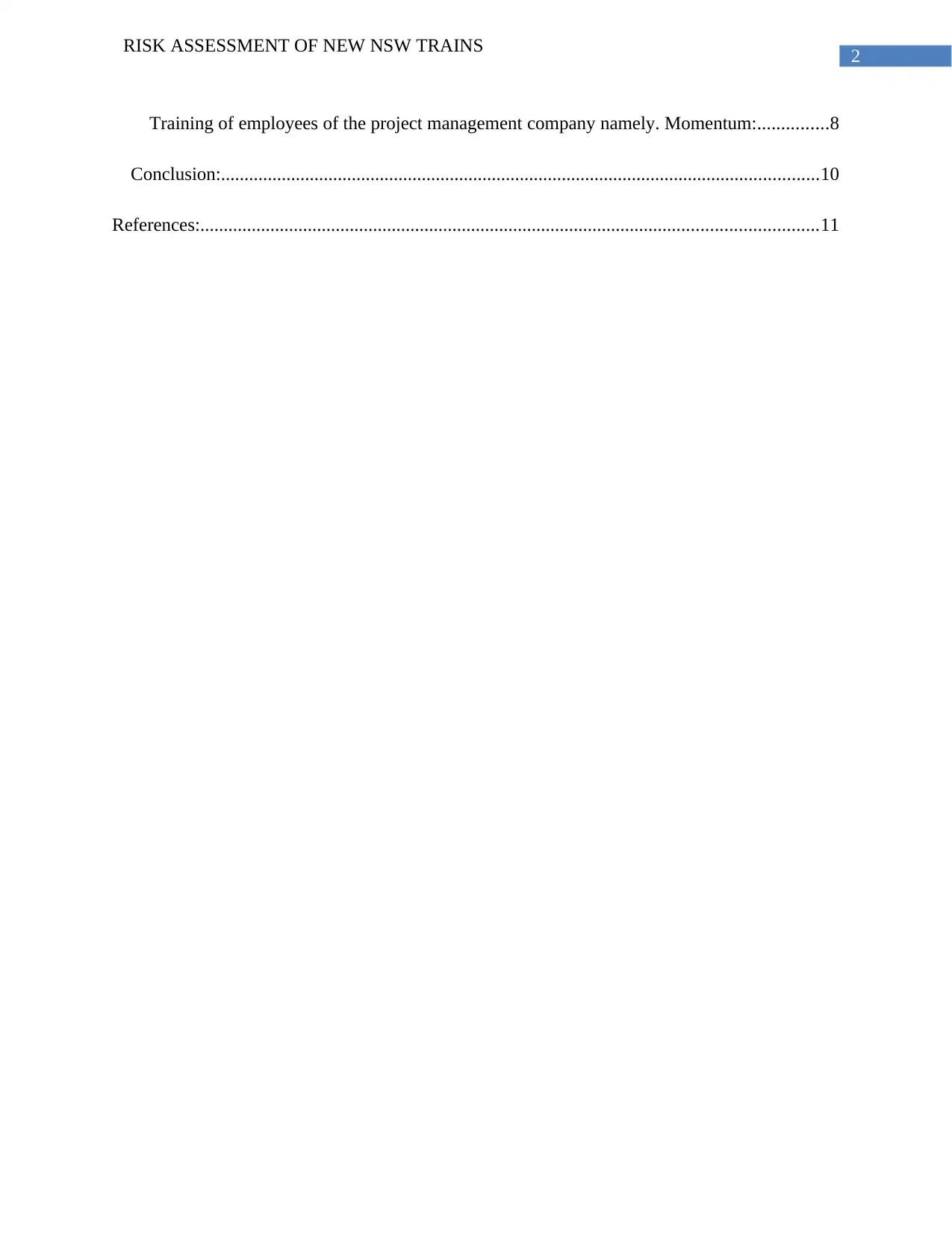
2
RISK ASSESSMENT OF NEW NSW TRAINS
Training of employees of the project management company namely. Momentum:...............8
Conclusion:................................................................................................................................10
References:....................................................................................................................................11
RISK ASSESSMENT OF NEW NSW TRAINS
Training of employees of the project management company namely. Momentum:...............8
Conclusion:................................................................................................................................10
References:....................................................................................................................................11
⊘ This is a preview!⊘
Do you want full access?
Subscribe today to unlock all pages.

Trusted by 1+ million students worldwide
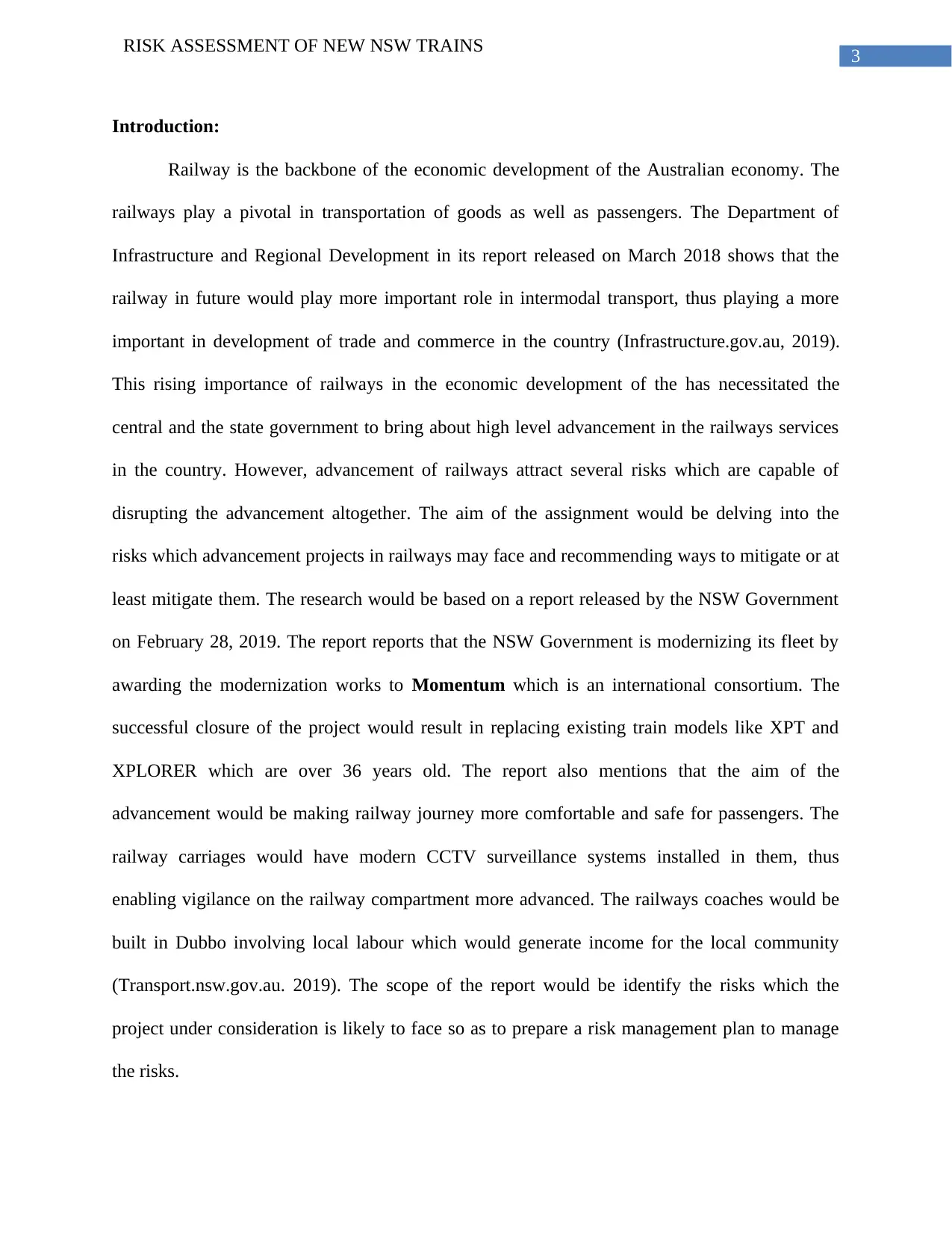
3
RISK ASSESSMENT OF NEW NSW TRAINS
Introduction:
Railway is the backbone of the economic development of the Australian economy. The
railways play a pivotal in transportation of goods as well as passengers. The Department of
Infrastructure and Regional Development in its report released on March 2018 shows that the
railway in future would play more important role in intermodal transport, thus playing a more
important in development of trade and commerce in the country (Infrastructure.gov.au, 2019).
This rising importance of railways in the economic development of the has necessitated the
central and the state government to bring about high level advancement in the railways services
in the country. However, advancement of railways attract several risks which are capable of
disrupting the advancement altogether. The aim of the assignment would be delving into the
risks which advancement projects in railways may face and recommending ways to mitigate or at
least mitigate them. The research would be based on a report released by the NSW Government
on February 28, 2019. The report reports that the NSW Government is modernizing its fleet by
awarding the modernization works to Momentum which is an international consortium. The
successful closure of the project would result in replacing existing train models like XPT and
XPLORER which are over 36 years old. The report also mentions that the aim of the
advancement would be making railway journey more comfortable and safe for passengers. The
railway carriages would have modern CCTV surveillance systems installed in them, thus
enabling vigilance on the railway compartment more advanced. The railways coaches would be
built in Dubbo involving local labour which would generate income for the local community
(Transport.nsw.gov.au. 2019). The scope of the report would be identify the risks which the
project under consideration is likely to face so as to prepare a risk management plan to manage
the risks.
RISK ASSESSMENT OF NEW NSW TRAINS
Introduction:
Railway is the backbone of the economic development of the Australian economy. The
railways play a pivotal in transportation of goods as well as passengers. The Department of
Infrastructure and Regional Development in its report released on March 2018 shows that the
railway in future would play more important role in intermodal transport, thus playing a more
important in development of trade and commerce in the country (Infrastructure.gov.au, 2019).
This rising importance of railways in the economic development of the has necessitated the
central and the state government to bring about high level advancement in the railways services
in the country. However, advancement of railways attract several risks which are capable of
disrupting the advancement altogether. The aim of the assignment would be delving into the
risks which advancement projects in railways may face and recommending ways to mitigate or at
least mitigate them. The research would be based on a report released by the NSW Government
on February 28, 2019. The report reports that the NSW Government is modernizing its fleet by
awarding the modernization works to Momentum which is an international consortium. The
successful closure of the project would result in replacing existing train models like XPT and
XPLORER which are over 36 years old. The report also mentions that the aim of the
advancement would be making railway journey more comfortable and safe for passengers. The
railway carriages would have modern CCTV surveillance systems installed in them, thus
enabling vigilance on the railway compartment more advanced. The railways coaches would be
built in Dubbo involving local labour which would generate income for the local community
(Transport.nsw.gov.au. 2019). The scope of the report would be identify the risks which the
project under consideration is likely to face so as to prepare a risk management plan to manage
the risks.
Paraphrase This Document
Need a fresh take? Get an instant paraphrase of this document with our AI Paraphraser
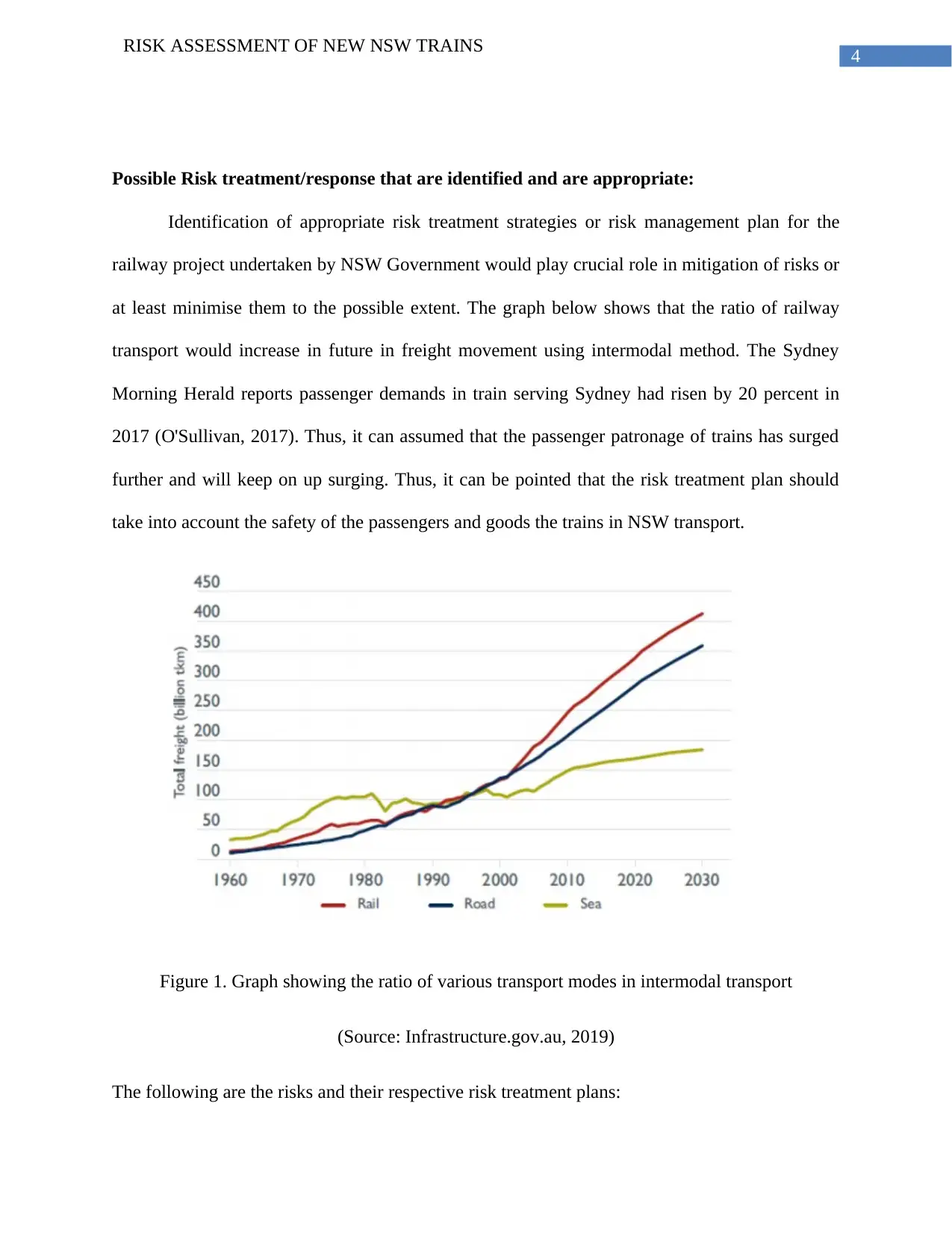
4
RISK ASSESSMENT OF NEW NSW TRAINS
Possible Risk treatment/response that are identified and are appropriate:
Identification of appropriate risk treatment strategies or risk management plan for the
railway project undertaken by NSW Government would play crucial role in mitigation of risks or
at least minimise them to the possible extent. The graph below shows that the ratio of railway
transport would increase in future in freight movement using intermodal method. The Sydney
Morning Herald reports passenger demands in train serving Sydney had risen by 20 percent in
2017 (O'Sullivan, 2017). Thus, it can assumed that the passenger patronage of trains has surged
further and will keep on up surging. Thus, it can be pointed that the risk treatment plan should
take into account the safety of the passengers and goods the trains in NSW transport.
Figure 1. Graph showing the ratio of various transport modes in intermodal transport
(Source: Infrastructure.gov.au, 2019)
The following are the risks and their respective risk treatment plans:
RISK ASSESSMENT OF NEW NSW TRAINS
Possible Risk treatment/response that are identified and are appropriate:
Identification of appropriate risk treatment strategies or risk management plan for the
railway project undertaken by NSW Government would play crucial role in mitigation of risks or
at least minimise them to the possible extent. The graph below shows that the ratio of railway
transport would increase in future in freight movement using intermodal method. The Sydney
Morning Herald reports passenger demands in train serving Sydney had risen by 20 percent in
2017 (O'Sullivan, 2017). Thus, it can assumed that the passenger patronage of trains has surged
further and will keep on up surging. Thus, it can be pointed that the risk treatment plan should
take into account the safety of the passengers and goods the trains in NSW transport.
Figure 1. Graph showing the ratio of various transport modes in intermodal transport
(Source: Infrastructure.gov.au, 2019)
The following are the risks and their respective risk treatment plans:
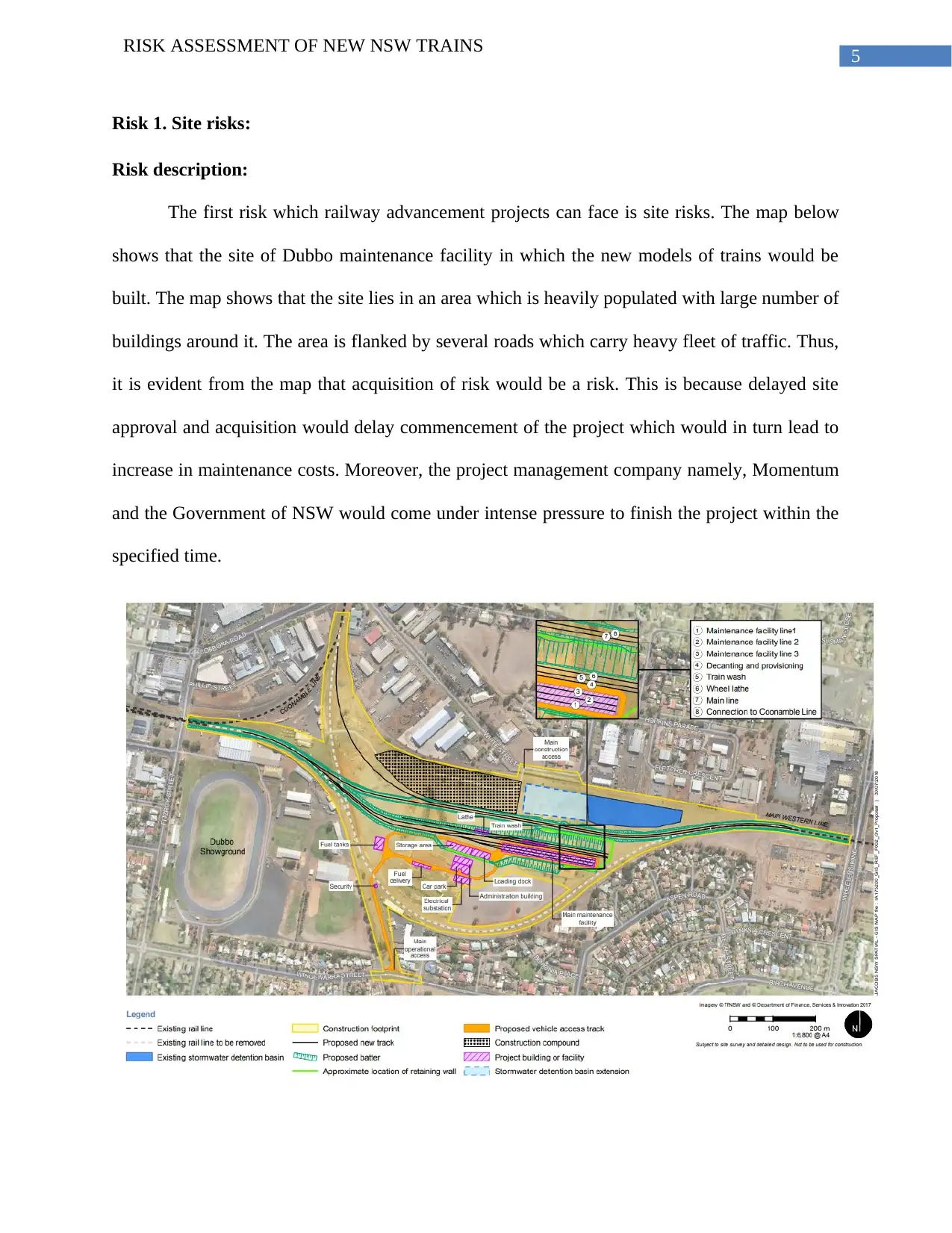
5
RISK ASSESSMENT OF NEW NSW TRAINS
Risk 1. Site risks:
Risk description:
The first risk which railway advancement projects can face is site risks. The map below
shows that the site of Dubbo maintenance facility in which the new models of trains would be
built. The map shows that the site lies in an area which is heavily populated with large number of
buildings around it. The area is flanked by several roads which carry heavy fleet of traffic. Thus,
it is evident from the map that acquisition of risk would be a risk. This is because delayed site
approval and acquisition would delay commencement of the project which would in turn lead to
increase in maintenance costs. Moreover, the project management company namely, Momentum
and the Government of NSW would come under intense pressure to finish the project within the
specified time.
RISK ASSESSMENT OF NEW NSW TRAINS
Risk 1. Site risks:
Risk description:
The first risk which railway advancement projects can face is site risks. The map below
shows that the site of Dubbo maintenance facility in which the new models of trains would be
built. The map shows that the site lies in an area which is heavily populated with large number of
buildings around it. The area is flanked by several roads which carry heavy fleet of traffic. Thus,
it is evident from the map that acquisition of risk would be a risk. This is because delayed site
approval and acquisition would delay commencement of the project which would in turn lead to
increase in maintenance costs. Moreover, the project management company namely, Momentum
and the Government of NSW would come under intense pressure to finish the project within the
specified time.
⊘ This is a preview!⊘
Do you want full access?
Subscribe today to unlock all pages.

Trusted by 1+ million students worldwide
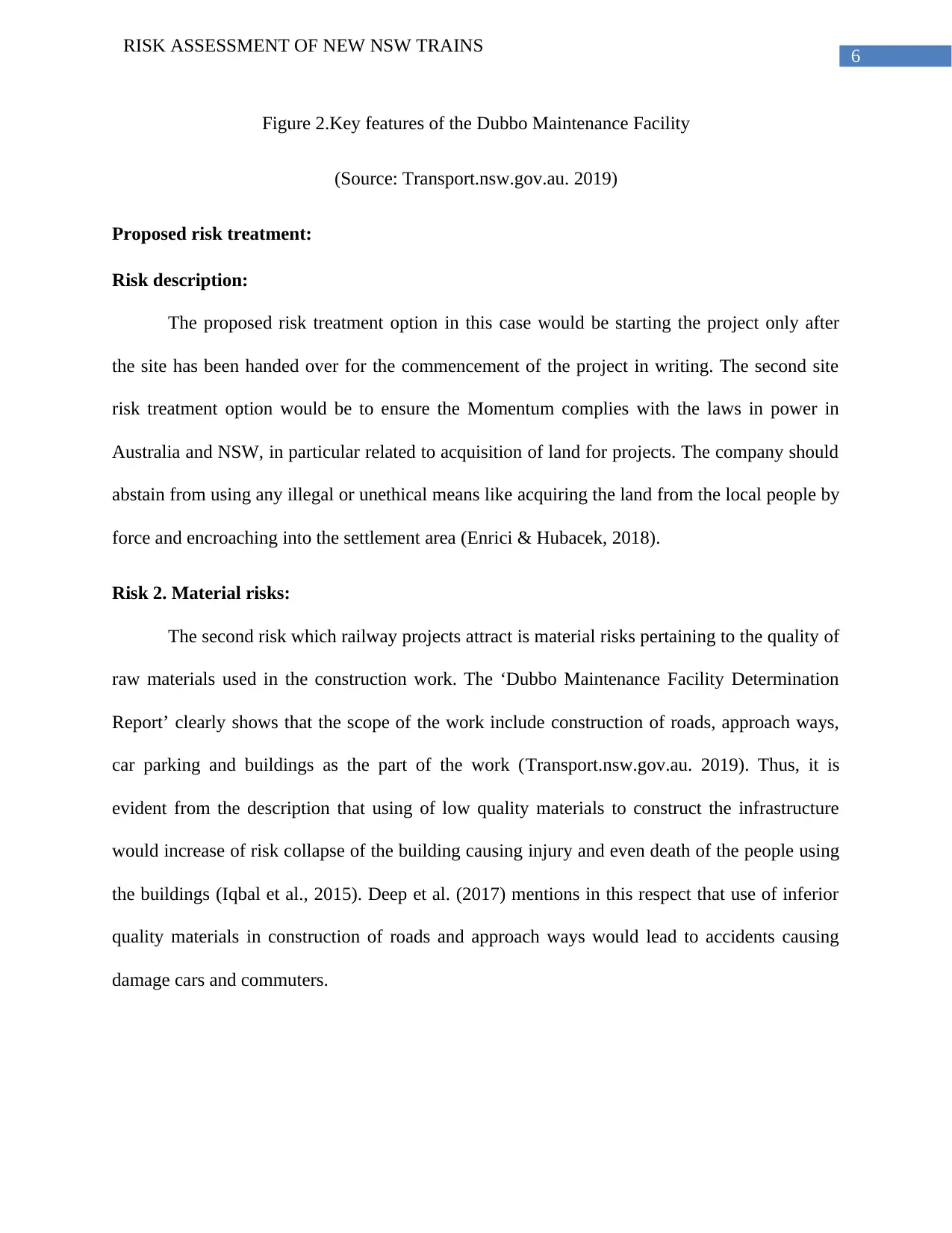
6
RISK ASSESSMENT OF NEW NSW TRAINS
Figure 2.Key features of the Dubbo Maintenance Facility
(Source: Transport.nsw.gov.au. 2019)
Proposed risk treatment:
Risk description:
The proposed risk treatment option in this case would be starting the project only after
the site has been handed over for the commencement of the project in writing. The second site
risk treatment option would be to ensure the Momentum complies with the laws in power in
Australia and NSW, in particular related to acquisition of land for projects. The company should
abstain from using any illegal or unethical means like acquiring the land from the local people by
force and encroaching into the settlement area (Enrici & Hubacek, 2018).
Risk 2. Material risks:
The second risk which railway projects attract is material risks pertaining to the quality of
raw materials used in the construction work. The ‘Dubbo Maintenance Facility Determination
Report’ clearly shows that the scope of the work include construction of roads, approach ways,
car parking and buildings as the part of the work (Transport.nsw.gov.au. 2019). Thus, it is
evident from the description that using of low quality materials to construct the infrastructure
would increase of risk collapse of the building causing injury and even death of the people using
the buildings (Iqbal et al., 2015). Deep et al. (2017) mentions in this respect that use of inferior
quality materials in construction of roads and approach ways would lead to accidents causing
damage cars and commuters.
RISK ASSESSMENT OF NEW NSW TRAINS
Figure 2.Key features of the Dubbo Maintenance Facility
(Source: Transport.nsw.gov.au. 2019)
Proposed risk treatment:
Risk description:
The proposed risk treatment option in this case would be starting the project only after
the site has been handed over for the commencement of the project in writing. The second site
risk treatment option would be to ensure the Momentum complies with the laws in power in
Australia and NSW, in particular related to acquisition of land for projects. The company should
abstain from using any illegal or unethical means like acquiring the land from the local people by
force and encroaching into the settlement area (Enrici & Hubacek, 2018).
Risk 2. Material risks:
The second risk which railway projects attract is material risks pertaining to the quality of
raw materials used in the construction work. The ‘Dubbo Maintenance Facility Determination
Report’ clearly shows that the scope of the work include construction of roads, approach ways,
car parking and buildings as the part of the work (Transport.nsw.gov.au. 2019). Thus, it is
evident from the description that using of low quality materials to construct the infrastructure
would increase of risk collapse of the building causing injury and even death of the people using
the buildings (Iqbal et al., 2015). Deep et al. (2017) mentions in this respect that use of inferior
quality materials in construction of roads and approach ways would lead to accidents causing
damage cars and commuters.
Paraphrase This Document
Need a fresh take? Get an instant paraphrase of this document with our AI Paraphraser
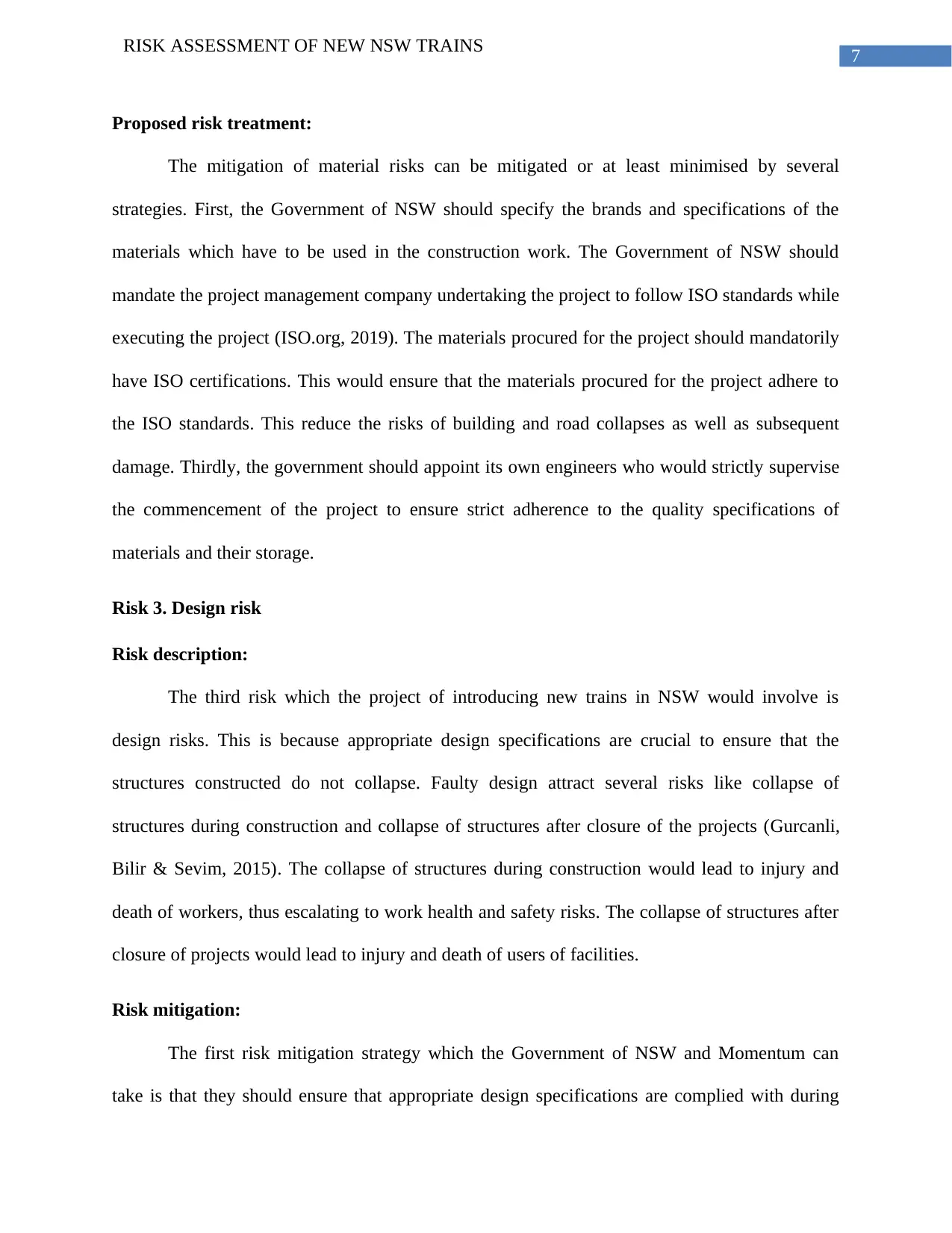
7
RISK ASSESSMENT OF NEW NSW TRAINS
Proposed risk treatment:
The mitigation of material risks can be mitigated or at least minimised by several
strategies. First, the Government of NSW should specify the brands and specifications of the
materials which have to be used in the construction work. The Government of NSW should
mandate the project management company undertaking the project to follow ISO standards while
executing the project (ISO.org, 2019). The materials procured for the project should mandatorily
have ISO certifications. This would ensure that the materials procured for the project adhere to
the ISO standards. This reduce the risks of building and road collapses as well as subsequent
damage. Thirdly, the government should appoint its own engineers who would strictly supervise
the commencement of the project to ensure strict adherence to the quality specifications of
materials and their storage.
Risk 3. Design risk
Risk description:
The third risk which the project of introducing new trains in NSW would involve is
design risks. This is because appropriate design specifications are crucial to ensure that the
structures constructed do not collapse. Faulty design attract several risks like collapse of
structures during construction and collapse of structures after closure of the projects (Gurcanli,
Bilir & Sevim, 2015). The collapse of structures during construction would lead to injury and
death of workers, thus escalating to work health and safety risks. The collapse of structures after
closure of projects would lead to injury and death of users of facilities.
Risk mitigation:
The first risk mitigation strategy which the Government of NSW and Momentum can
take is that they should ensure that appropriate design specifications are complied with during
RISK ASSESSMENT OF NEW NSW TRAINS
Proposed risk treatment:
The mitigation of material risks can be mitigated or at least minimised by several
strategies. First, the Government of NSW should specify the brands and specifications of the
materials which have to be used in the construction work. The Government of NSW should
mandate the project management company undertaking the project to follow ISO standards while
executing the project (ISO.org, 2019). The materials procured for the project should mandatorily
have ISO certifications. This would ensure that the materials procured for the project adhere to
the ISO standards. This reduce the risks of building and road collapses as well as subsequent
damage. Thirdly, the government should appoint its own engineers who would strictly supervise
the commencement of the project to ensure strict adherence to the quality specifications of
materials and their storage.
Risk 3. Design risk
Risk description:
The third risk which the project of introducing new trains in NSW would involve is
design risks. This is because appropriate design specifications are crucial to ensure that the
structures constructed do not collapse. Faulty design attract several risks like collapse of
structures during construction and collapse of structures after closure of the projects (Gurcanli,
Bilir & Sevim, 2015). The collapse of structures during construction would lead to injury and
death of workers, thus escalating to work health and safety risks. The collapse of structures after
closure of projects would lead to injury and death of users of facilities.
Risk mitigation:
The first risk mitigation strategy which the Government of NSW and Momentum can
take is that they should ensure that appropriate design specifications are complied with during
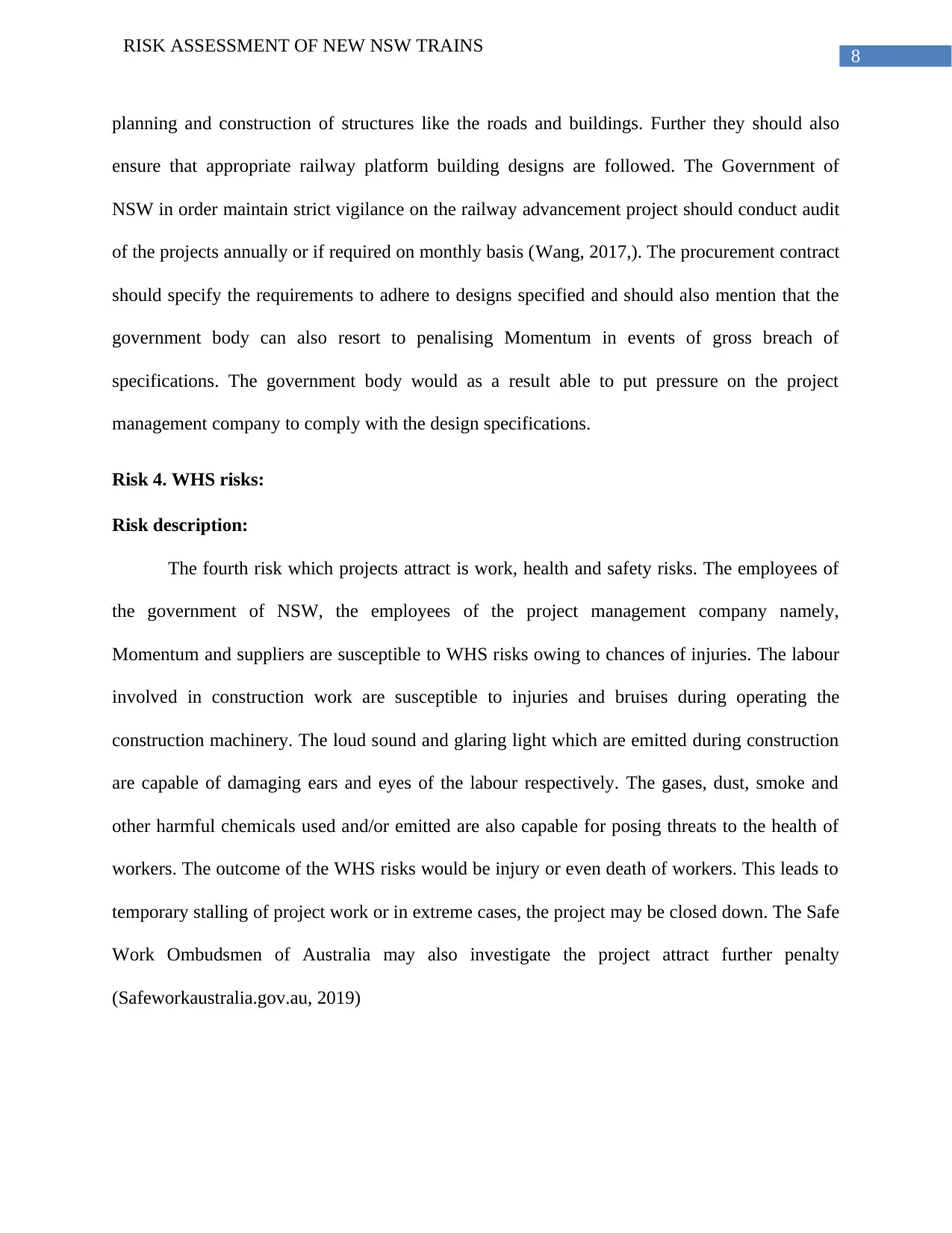
8
RISK ASSESSMENT OF NEW NSW TRAINS
planning and construction of structures like the roads and buildings. Further they should also
ensure that appropriate railway platform building designs are followed. The Government of
NSW in order maintain strict vigilance on the railway advancement project should conduct audit
of the projects annually or if required on monthly basis (Wang, 2017,). The procurement contract
should specify the requirements to adhere to designs specified and should also mention that the
government body can also resort to penalising Momentum in events of gross breach of
specifications. The government body would as a result able to put pressure on the project
management company to comply with the design specifications.
Risk 4. WHS risks:
Risk description:
The fourth risk which projects attract is work, health and safety risks. The employees of
the government of NSW, the employees of the project management company namely,
Momentum and suppliers are susceptible to WHS risks owing to chances of injuries. The labour
involved in construction work are susceptible to injuries and bruises during operating the
construction machinery. The loud sound and glaring light which are emitted during construction
are capable of damaging ears and eyes of the labour respectively. The gases, dust, smoke and
other harmful chemicals used and/or emitted are also capable for posing threats to the health of
workers. The outcome of the WHS risks would be injury or even death of workers. This leads to
temporary stalling of project work or in extreme cases, the project may be closed down. The Safe
Work Ombudsmen of Australia may also investigate the project attract further penalty
(Safeworkaustralia.gov.au, 2019)
RISK ASSESSMENT OF NEW NSW TRAINS
planning and construction of structures like the roads and buildings. Further they should also
ensure that appropriate railway platform building designs are followed. The Government of
NSW in order maintain strict vigilance on the railway advancement project should conduct audit
of the projects annually or if required on monthly basis (Wang, 2017,). The procurement contract
should specify the requirements to adhere to designs specified and should also mention that the
government body can also resort to penalising Momentum in events of gross breach of
specifications. The government body would as a result able to put pressure on the project
management company to comply with the design specifications.
Risk 4. WHS risks:
Risk description:
The fourth risk which projects attract is work, health and safety risks. The employees of
the government of NSW, the employees of the project management company namely,
Momentum and suppliers are susceptible to WHS risks owing to chances of injuries. The labour
involved in construction work are susceptible to injuries and bruises during operating the
construction machinery. The loud sound and glaring light which are emitted during construction
are capable of damaging ears and eyes of the labour respectively. The gases, dust, smoke and
other harmful chemicals used and/or emitted are also capable for posing threats to the health of
workers. The outcome of the WHS risks would be injury or even death of workers. This leads to
temporary stalling of project work or in extreme cases, the project may be closed down. The Safe
Work Ombudsmen of Australia may also investigate the project attract further penalty
(Safeworkaustralia.gov.au, 2019)
⊘ This is a preview!⊘
Do you want full access?
Subscribe today to unlock all pages.

Trusted by 1+ million students worldwide
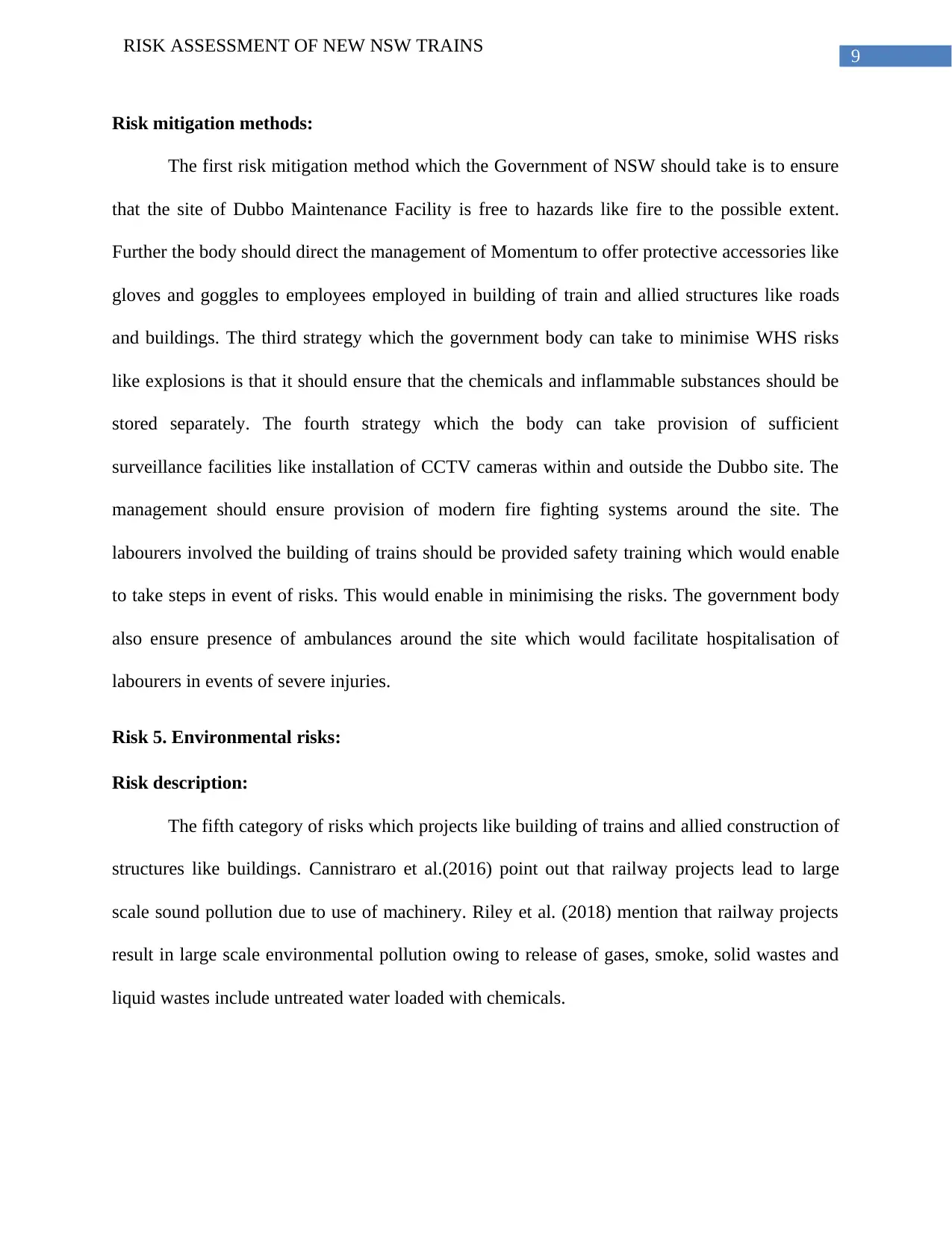
9
RISK ASSESSMENT OF NEW NSW TRAINS
Risk mitigation methods:
The first risk mitigation method which the Government of NSW should take is to ensure
that the site of Dubbo Maintenance Facility is free to hazards like fire to the possible extent.
Further the body should direct the management of Momentum to offer protective accessories like
gloves and goggles to employees employed in building of train and allied structures like roads
and buildings. The third strategy which the government body can take to minimise WHS risks
like explosions is that it should ensure that the chemicals and inflammable substances should be
stored separately. The fourth strategy which the body can take provision of sufficient
surveillance facilities like installation of CCTV cameras within and outside the Dubbo site. The
management should ensure provision of modern fire fighting systems around the site. The
labourers involved the building of trains should be provided safety training which would enable
to take steps in event of risks. This would enable in minimising the risks. The government body
also ensure presence of ambulances around the site which would facilitate hospitalisation of
labourers in events of severe injuries.
Risk 5. Environmental risks:
Risk description:
The fifth category of risks which projects like building of trains and allied construction of
structures like buildings. Cannistraro et al.(2016) point out that railway projects lead to large
scale sound pollution due to use of machinery. Riley et al. (2018) mention that railway projects
result in large scale environmental pollution owing to release of gases, smoke, solid wastes and
liquid wastes include untreated water loaded with chemicals.
RISK ASSESSMENT OF NEW NSW TRAINS
Risk mitigation methods:
The first risk mitigation method which the Government of NSW should take is to ensure
that the site of Dubbo Maintenance Facility is free to hazards like fire to the possible extent.
Further the body should direct the management of Momentum to offer protective accessories like
gloves and goggles to employees employed in building of train and allied structures like roads
and buildings. The third strategy which the government body can take to minimise WHS risks
like explosions is that it should ensure that the chemicals and inflammable substances should be
stored separately. The fourth strategy which the body can take provision of sufficient
surveillance facilities like installation of CCTV cameras within and outside the Dubbo site. The
management should ensure provision of modern fire fighting systems around the site. The
labourers involved the building of trains should be provided safety training which would enable
to take steps in event of risks. This would enable in minimising the risks. The government body
also ensure presence of ambulances around the site which would facilitate hospitalisation of
labourers in events of severe injuries.
Risk 5. Environmental risks:
Risk description:
The fifth category of risks which projects like building of trains and allied construction of
structures like buildings. Cannistraro et al.(2016) point out that railway projects lead to large
scale sound pollution due to use of machinery. Riley et al. (2018) mention that railway projects
result in large scale environmental pollution owing to release of gases, smoke, solid wastes and
liquid wastes include untreated water loaded with chemicals.
Paraphrase This Document
Need a fresh take? Get an instant paraphrase of this document with our AI Paraphraser
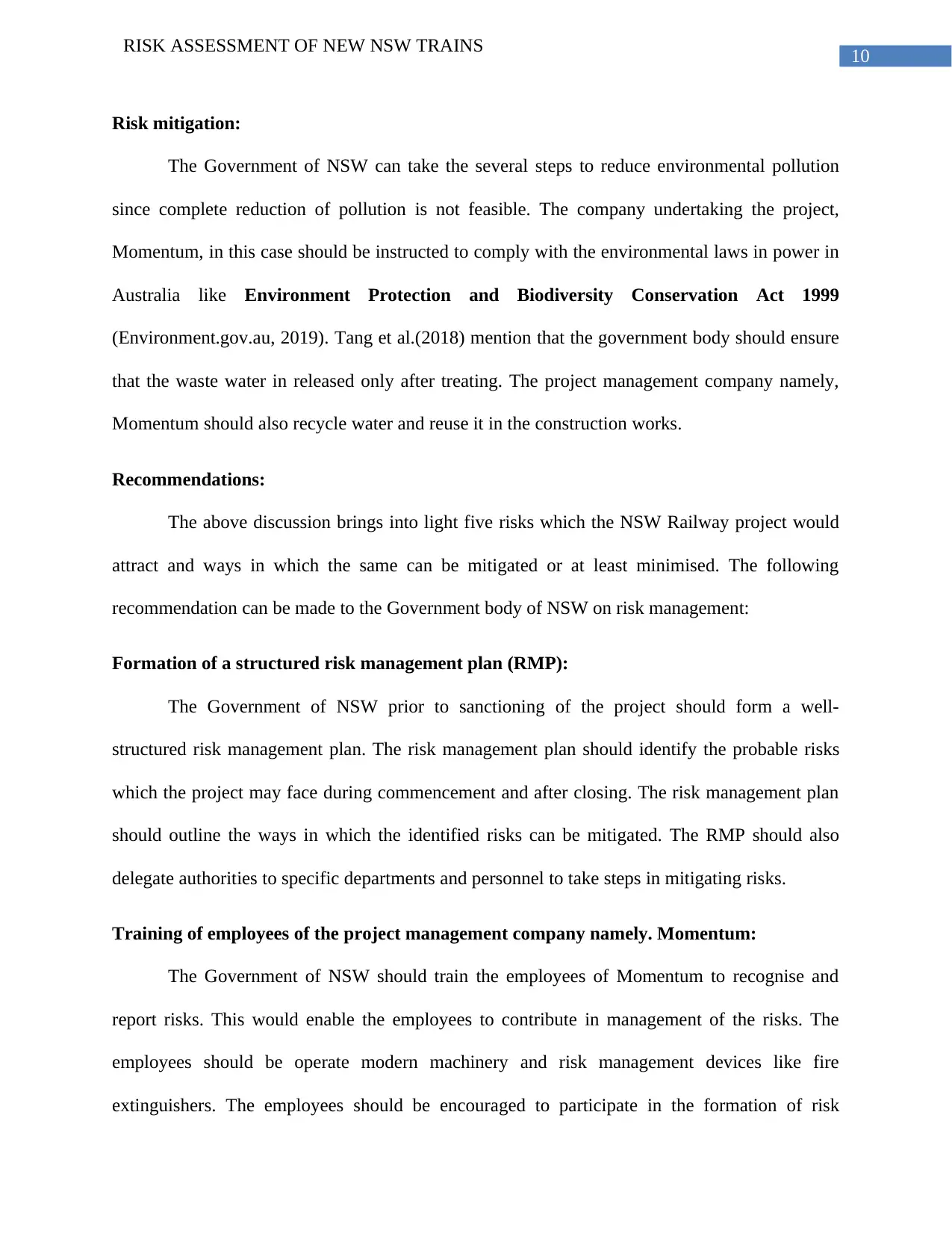
10
RISK ASSESSMENT OF NEW NSW TRAINS
Risk mitigation:
The Government of NSW can take the several steps to reduce environmental pollution
since complete reduction of pollution is not feasible. The company undertaking the project,
Momentum, in this case should be instructed to comply with the environmental laws in power in
Australia like Environment Protection and Biodiversity Conservation Act 1999
(Environment.gov.au, 2019). Tang et al.(2018) mention that the government body should ensure
that the waste water in released only after treating. The project management company namely,
Momentum should also recycle water and reuse it in the construction works.
Recommendations:
The above discussion brings into light five risks which the NSW Railway project would
attract and ways in which the same can be mitigated or at least minimised. The following
recommendation can be made to the Government body of NSW on risk management:
Formation of a structured risk management plan (RMP):
The Government of NSW prior to sanctioning of the project should form a well-
structured risk management plan. The risk management plan should identify the probable risks
which the project may face during commencement and after closing. The risk management plan
should outline the ways in which the identified risks can be mitigated. The RMP should also
delegate authorities to specific departments and personnel to take steps in mitigating risks.
Training of employees of the project management company namely. Momentum:
The Government of NSW should train the employees of Momentum to recognise and
report risks. This would enable the employees to contribute in management of the risks. The
employees should be operate modern machinery and risk management devices like fire
extinguishers. The employees should be encouraged to participate in the formation of risk
RISK ASSESSMENT OF NEW NSW TRAINS
Risk mitigation:
The Government of NSW can take the several steps to reduce environmental pollution
since complete reduction of pollution is not feasible. The company undertaking the project,
Momentum, in this case should be instructed to comply with the environmental laws in power in
Australia like Environment Protection and Biodiversity Conservation Act 1999
(Environment.gov.au, 2019). Tang et al.(2018) mention that the government body should ensure
that the waste water in released only after treating. The project management company namely,
Momentum should also recycle water and reuse it in the construction works.
Recommendations:
The above discussion brings into light five risks which the NSW Railway project would
attract and ways in which the same can be mitigated or at least minimised. The following
recommendation can be made to the Government body of NSW on risk management:
Formation of a structured risk management plan (RMP):
The Government of NSW prior to sanctioning of the project should form a well-
structured risk management plan. The risk management plan should identify the probable risks
which the project may face during commencement and after closing. The risk management plan
should outline the ways in which the identified risks can be mitigated. The RMP should also
delegate authorities to specific departments and personnel to take steps in mitigating risks.
Training of employees of the project management company namely. Momentum:
The Government of NSW should train the employees of Momentum to recognise and
report risks. This would enable the employees to contribute in management of the risks. The
employees should be operate modern machinery and risk management devices like fire
extinguishers. The employees should be encouraged to participate in the formation of risk
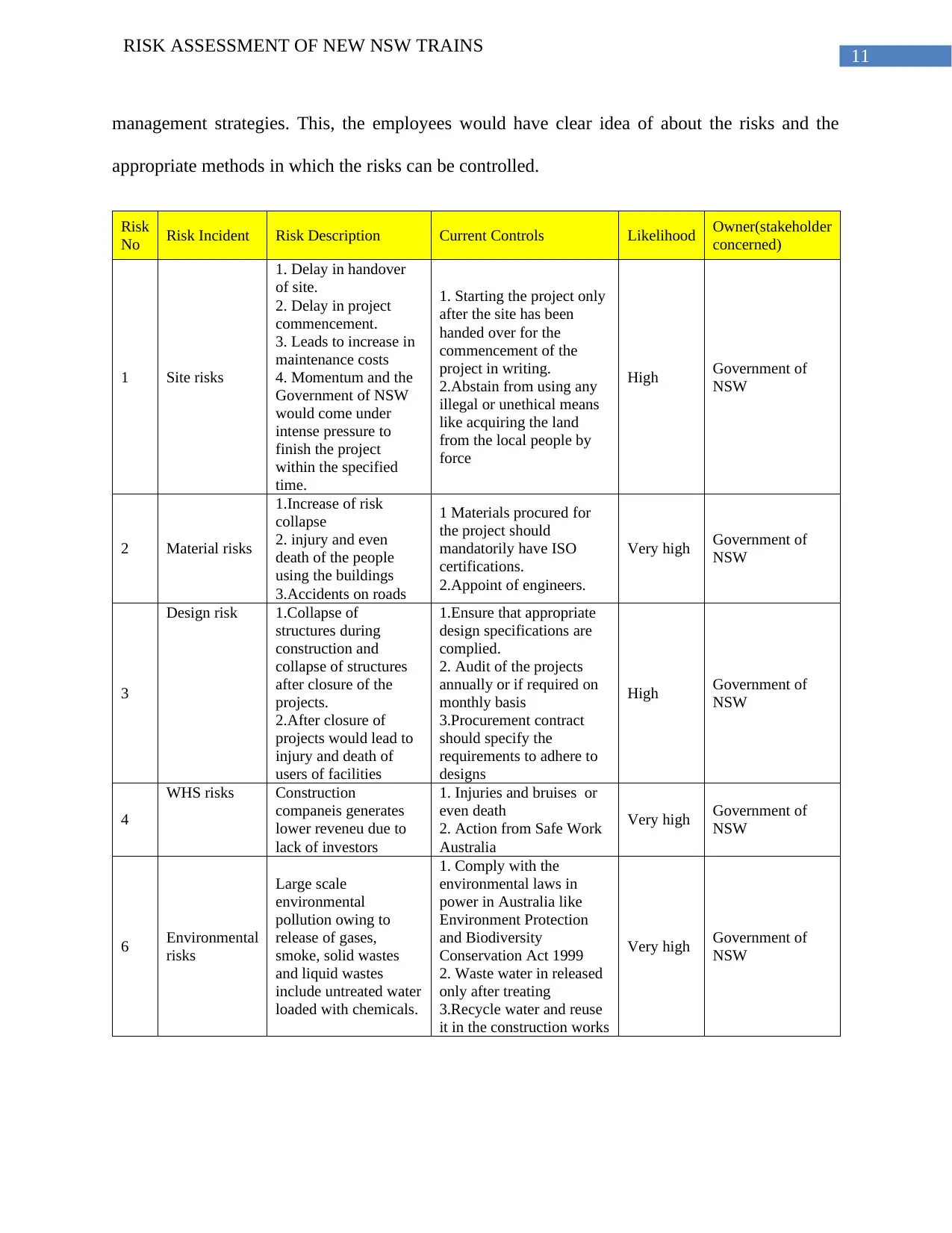
11
RISK ASSESSMENT OF NEW NSW TRAINS
management strategies. This, the employees would have clear idea of about the risks and the
appropriate methods in which the risks can be controlled.
Risk
No Risk Incident Risk Description Current Controls Likelihood Owner(stakeholder
concerned)
1 Site risks
1. Delay in handover
of site.
2. Delay in project
commencement.
3. Leads to increase in
maintenance costs
4. Momentum and the
Government of NSW
would come under
intense pressure to
finish the project
within the specified
time.
1. Starting the project only
after the site has been
handed over for the
commencement of the
project in writing.
2.Abstain from using any
illegal or unethical means
like acquiring the land
from the local people by
force
High Government of
NSW
2 Material risks
1.Increase of risk
collapse
2. injury and even
death of the people
using the buildings
3.Accidents on roads
1 Materials procured for
the project should
mandatorily have ISO
certifications.
2.Appoint of engineers.
Very high Government of
NSW
3
Design risk 1.Collapse of
structures during
construction and
collapse of structures
after closure of the
projects.
2.After closure of
projects would lead to
injury and death of
users of facilities
1.Ensure that appropriate
design specifications are
complied.
2. Audit of the projects
annually or if required on
monthly basis
3.Procurement contract
should specify the
requirements to adhere to
designs
High Government of
NSW
4
WHS risks Construction
companeis generates
lower reveneu due to
lack of investors
1. Injuries and bruises or
even death
2. Action from Safe Work
Australia
Very high Government of
NSW
6 Environmental
risks
Large scale
environmental
pollution owing to
release of gases,
smoke, solid wastes
and liquid wastes
include untreated water
loaded with chemicals.
1. Comply with the
environmental laws in
power in Australia like
Environment Protection
and Biodiversity
Conservation Act 1999
2. Waste water in released
only after treating
3.Recycle water and reuse
it in the construction works
Very high Government of
NSW
RISK ASSESSMENT OF NEW NSW TRAINS
management strategies. This, the employees would have clear idea of about the risks and the
appropriate methods in which the risks can be controlled.
Risk
No Risk Incident Risk Description Current Controls Likelihood Owner(stakeholder
concerned)
1 Site risks
1. Delay in handover
of site.
2. Delay in project
commencement.
3. Leads to increase in
maintenance costs
4. Momentum and the
Government of NSW
would come under
intense pressure to
finish the project
within the specified
time.
1. Starting the project only
after the site has been
handed over for the
commencement of the
project in writing.
2.Abstain from using any
illegal or unethical means
like acquiring the land
from the local people by
force
High Government of
NSW
2 Material risks
1.Increase of risk
collapse
2. injury and even
death of the people
using the buildings
3.Accidents on roads
1 Materials procured for
the project should
mandatorily have ISO
certifications.
2.Appoint of engineers.
Very high Government of
NSW
3
Design risk 1.Collapse of
structures during
construction and
collapse of structures
after closure of the
projects.
2.After closure of
projects would lead to
injury and death of
users of facilities
1.Ensure that appropriate
design specifications are
complied.
2. Audit of the projects
annually or if required on
monthly basis
3.Procurement contract
should specify the
requirements to adhere to
designs
High Government of
NSW
4
WHS risks Construction
companeis generates
lower reveneu due to
lack of investors
1. Injuries and bruises or
even death
2. Action from Safe Work
Australia
Very high Government of
NSW
6 Environmental
risks
Large scale
environmental
pollution owing to
release of gases,
smoke, solid wastes
and liquid wastes
include untreated water
loaded with chemicals.
1. Comply with the
environmental laws in
power in Australia like
Environment Protection
and Biodiversity
Conservation Act 1999
2. Waste water in released
only after treating
3.Recycle water and reuse
it in the construction works
Very high Government of
NSW
⊘ This is a preview!⊘
Do you want full access?
Subscribe today to unlock all pages.

Trusted by 1+ million students worldwide
1 out of 16
Related Documents
Your All-in-One AI-Powered Toolkit for Academic Success.
+13062052269
info@desklib.com
Available 24*7 on WhatsApp / Email
![[object Object]](/_next/static/media/star-bottom.7253800d.svg)
Unlock your academic potential
Copyright © 2020–2025 A2Z Services. All Rights Reserved. Developed and managed by ZUCOL.





